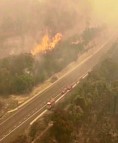Twenty years on since the 1994 fires - Seven News Flashback
Published Date: 06 Jan 2014

Summary
This month marks two significant anniversaries for the NSW RFS – the tragic January 1994 bush fires which affected large parts of the state, and the January 2013 bush fires which are still having long-lasting effects on local communities.
From: Shane Fitzsimmons
Sent: Tuesday, 7 January 2014 4:29 PM
To: All Staff
Subject: Anniversaries
Afternoon All
The 1994 bush fires were a watershed moment not only for the people of NSW but for the broader firefighting community. Over a three week period, fire dominated the coast and ranges from the Queensland border in the north down to Batemans Bay in the south, as well as the more heavily populated areas of Greater Sydney, Blue Mountains and Central Coast.
Four lives were lost during these fires, 1 civilian and 3 members. A 42 year old mother died as she sought shelter in a swimming pool from fire burning in Como Jannali. Robert Page, a volunteer from Wingecarribee, died when a tree fell on the cabin of his tanker whilst patrolling and mopping up a fire in the Double Duke Forest near Grafton. Norman Anthes, a volunteer from Lithgow, died whilst felling a tree as part of mopping up the Mount Horrible fire near Lithgow. Clinton Westwood, a 17 year old volunteer with Wollondilly, died when his tanker crashed whilst responding to a fire call. Norm and Bob were killed on the same day, 4 January 1994 and Clinton on 29 January 1994. The fires also destroyed 225 homes and 800,000 hectares of bushland.
These fires, and a lengthy Coronial inquest following them, were the catalyst for forming today's modern Rural Fire Service.
It is true to say we've come a long way in the last 20 years, and we have learned a lot from these experiences. Legislation and policy improvements along with modern, purpose built appliances and equipment, training and PPE, as well as technological advancements, investments in infrastructure and the integration of specialised resources such as aircraft into fire management and response practices are all examples of such.
This was evidenced during January 2013, one of the first major fire emergencies for NSW since the recent introduction of measures such as new Fire Danger Ratings, Alerts Levels, telephone warnings and so on.
It was on this day, 7 January 2013, that we saw Catastrophic fire danger ratings across forested areas with large population centres, for the first time. More than a million telephone warnings were sent out to warn the community of the conditions, and about fires in areas such as the Shoalhaven, Yass, Cooma and days later, a large and destructive fire which destroyed more than 50 homes near Coonabarabran. Most pleasingly of course, is that there was no loss of life despite the weather and fire conditions.
Whiles times and technology have changed, there's been a constant – that is the work of our members, investing in prevention and mitigation programmes and of course, pitching in during a time of crisis to protect not only their own community, but also those further afield.
Far too many members have paid the ultimate sacrifice whilst simply seeking to serve and protect their community. Unfortunately, 67 names of RFS members appear on the Volunteer Services Memorial in the Domain in recognition of those that have lost their life in the line of duty, 21 of which have been added since the devastating fires of January 1994.
This week, Channel Seven aired an interesting look back at the fires of 1994, which you can see online at http://youtu.be/FYy5Opj6yHo. You may see some familiar faces from 20 years ago in this story which shows how far we've come.
We need to acknowledge and thank all members, both past and present, for their ongoing dedication and commitment to learning from events of the past in order to provide a safer and more professional service to the community.
Regards, Shane
Channel 7 looks at how fire fighting has evolved since the 1994 bush fires in its flashback.



